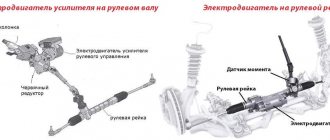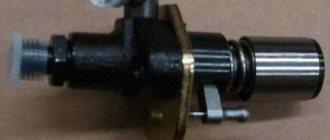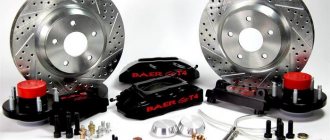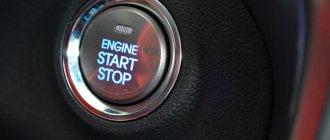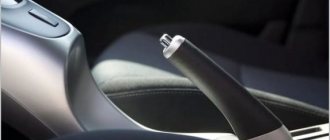The ESS Emergency Brake Warning System is a special system that informs drivers of emergency braking by the vehicle in front. Alert about sudden deceleration of a vehicle helps motorists avoid an accident, and in some cases can save the lives of road users. Let's look at the operating principle of the ESS (Emergency Stop Signal System) system, its main advantages, and also find out which manufacturers integrate this option into their cars.
Principle of operation
On the left - the hazard lights are turned on manually, on the right - the hazard lights are turned on by the ESS system. The
warning system for the driver of a vehicle behind during emergency braking has the following principle of operation. Every time the vehicle decelerates, the emergency brake sensor compares the force with which the driver presses the brake pedal with a default threshold value. Exceeding the designated limit activates not only the brake lights during braking, but also the hazard lights, which begin to flash rapidly. This way, drivers following a car that suddenly stops know in advance that they need to brake immediately, otherwise they risk getting into an accident.
The additional indication of alarm signals is switched off after the driver releases the brake pedal. The emergency braking alert is fully automatic and the driver does not take any action.
ESS system
It often happens that the car driving ahead begins to brake quickly. There is nothing special here, because any vehicle is simply obliged to brake; this maneuver is an integral part of the movement. But the whole point of the situation is that, despite all the measures you have taken, the car in front continues to inevitably approach.
The reason for this is different braking, the first car brakes with all its might, the pedal is pressed to the floor, and you brake slowly and carefully, naturally, your braking distance will be longer. The ESS emergency braking warning system is designed to insure you against such situations, or rather, their dangerous consequences.
What is ESS
Emergency braking technology is designed to at least reduce the consequences of an accident that may occur, or not prevent it. That is, in a situation where you no longer have time to brake on your own, the automation takes control of the car and, guided by a number of additional parameters read from external sensors, controls the vehicle.
As a result of the program, the braking distance can be reduced by almost 20%, which in most cases is enough to prevent a collision and protect yourself and other road users from an accident.
Behind the letters ESS is a special technology that notifies cars behind you about your emergency braking. When the ESS system is triggered, the car turns on a visual alarm.
In other words, if not only the brake lights of the vehicle ahead, but also the hazard lights come on, it means that the situation near you is emergency, and the car is braking too sharply, almost on the verge of a foul. In such a case, you immediately need to do the same to avoid a collision.
Each of the well-known machine manufacturers produces ESS technology in its own way, and complements it with various sensors:
- Ford, Peugeout, BMW, Kia, Citroen, Mitsubishi, Opel, Hundai - turn on the hazard warning lights more frequently.
- Wolksvagen, Volvo - indicated by flashing brake lights.
- Mercedes - includes hazard warning lights, brake lights and fog lights.
The ESS emergency braking system can be of two types:
- helps with emergency braking initiated by the driver;
- activates slowdown on its own.
Important! The essence of the ESS system lies in an algorithm that is able to determine the force with which the driver of the car presses the brake pedal. The information is processed in the ESS block and helps the system brake correctly. As a result, the car stops faster.
This ESS system is much smarter and more thoughtful than the one described above, here all the work is done automatically, even if the driver is completely unoriented and fails to at least start braking in time, the system will take control into its own hands and stop the car in time.
A car equipped with a fully automatic ESS system is equipped with cameras and radars that monitor the car moving in front of you. When it starts to brake too sharply (urgently and without important reasons), the automatic system instantly works and slows down the car, insuring it from a collision.
Device and main components
The ess vehicle emergency braking warning system consists of the following components:
- Emergency braking sensor. Every deceleration of the car is monitored by an emergency braking sensor. If the set limit is exceeded (if the car brakes too sharply), a signal is sent to the actuators.
- Brake system. A sharply pressed brake pedal, in fact, is the initiator of a control signal for the actuators. In this case, the alarm system will stop working only after the driver releases the brake pedal.
- Actuators (alarm systems). The ESS system uses hazard lights or brake lights as actuators, and less commonly, fog lights.
What does such early warning provide?
As already noted, it is often quite difficult to determine when the car in front is braking very sharply. It takes at least 0.3 seconds for the driver to understand that he does not have time to brake normally. At a speed of sixty km/h, during this time the car will travel four meters of distance.
And this is already quite a lot, and in such a situation it can be very difficult to avoid a collision. Therefore, the use of ESS on a car, when the actuators (emergency lights) signal such a mode, directly affects traffic safety.
One of the ways that directly influences correct behavior on the road is to inform the drivers of cars behind about the maneuvers and actions performed by the driver. In particular, emergency braking warning solves this problem.
What else is worth reading
VAZ 2101 brake system
Parking brake system
How does traction control work?
Brake system
Application
Many automakers integrate ESS into their cars. However, the notification system is implemented differently by all companies. The difference is that manufacturers may use different signaling devices. For example, car hazard lights are included in the emergency braking warning system of the following brands: Opel, Peugeout, Ford, Citroen, Hyundai, BMW, Mitsubishi, KIA. Volvo and Volkswagen have brake lights. Mercedes vehicles alert drivers with three signaling devices: brake lights, hazard lights and fog lights.
Ideally, ESS should be integrated into every vehicle. It is not particularly complicated, but it brings enormous benefits to participants in the movement. Thanks to the warning system, drivers manage to avoid many collisions on the roads every day. After all, even short, intense braking with ESS does not go unnoticed.
How does the Brake Warning system work?
First of all, I would like to point out that different vehicles use different types of warning lights. These are standard car light signals, but operating in a non-standard mode, namely:
1. Rapid flashing of the hazard warning lights.
This warning method was chosen by the manufacturers of FORD, OPEL, BMW, and some French. For cars with good LED turn signals, this flashing is quite effective. For cars with conventional incandescent lamps, frequent blinking is perceived much worse. In addition, in many countries, hazard warning lights while driving are perceived as a sign of greeting or gratitude.
2. Flashing stops.
Used on some Volkswagen and Volvo cars. Feet are more visible. But in driving practice, many motorists often brake in a jerky manner, so such blinking may not be regarded as an emergency brake signal, but simply as a “game” with the brake pedal.
3. Simultaneous flashing of emergency lights, stop lights, repeaters, and fog lights.
This massive attack is used in some Mercedes and other luxury cars.
In my opinion, this is the most “attractive” (in the full sense) type of warning about an emergency braking situation.
Fully automatic braking system
This ESS system is much smarter and more thoughtful than the one described above, here all the work is done automatically, even if the driver is completely unoriented and fails to at least start braking in time, the system will take control into its own hands and stop the car in time.
A car equipped with a fully automatic ESS system is equipped with cameras and radars that monitor the car moving in front of you. When it starts to brake too sharply (urgently and without important reasons), the automatic system instantly works and slows down the car, insuring it from a collision.
What does using a warning system provide?
At the heart of it all lies a significant difference between different types of human reactions to external factors. If you rely on the visibility of traditional brake lights and the ability of drivers to quickly move from a calm state to an emergency state by assessing the speed of the leader's deceleration, then it will take too much time. The presence of strong light stimuli will help reduce it by about half; this will instantly mobilize the nervous system. In reality, you can estimate the time gain at about 300 milliseconds, which at normal city speeds will save about five meters of distance. They are usually not enough to prevent an incident.
Such efficiency is gradually causing the system to be used in most modern cars. And since its implementation does not require making changes to the design of the brake system, it is quite available in the form of installation kits for self-assembly. Such a relatively simple improvement to your car can help you avoid big troubles on the road.
Control of distance and traffic situation
A key element of INFINITI's automatic braking system is Forward Emergency Braking. It combines a complex of radars that scan the road ahead. Based on the data received, the FEB system calculates the distance to vehicles moving in front of INFINITI and their speed. If vehicles get too close, it automatically applies three levels of frontal collision protection:
- Warns the driver of danger with sound and light signals, simultaneously raising the accelerator pedal and increasing the tension of the seat belts.
- If there is no response to the alert and the distance between cars is further reduced, the standard brake is automatically applied to partially slow down.
- If the distance continues to decrease, FEB activates the emergency braking system to bring the car to a complete stop, which helps avoid an accident or mitigate its consequences.


